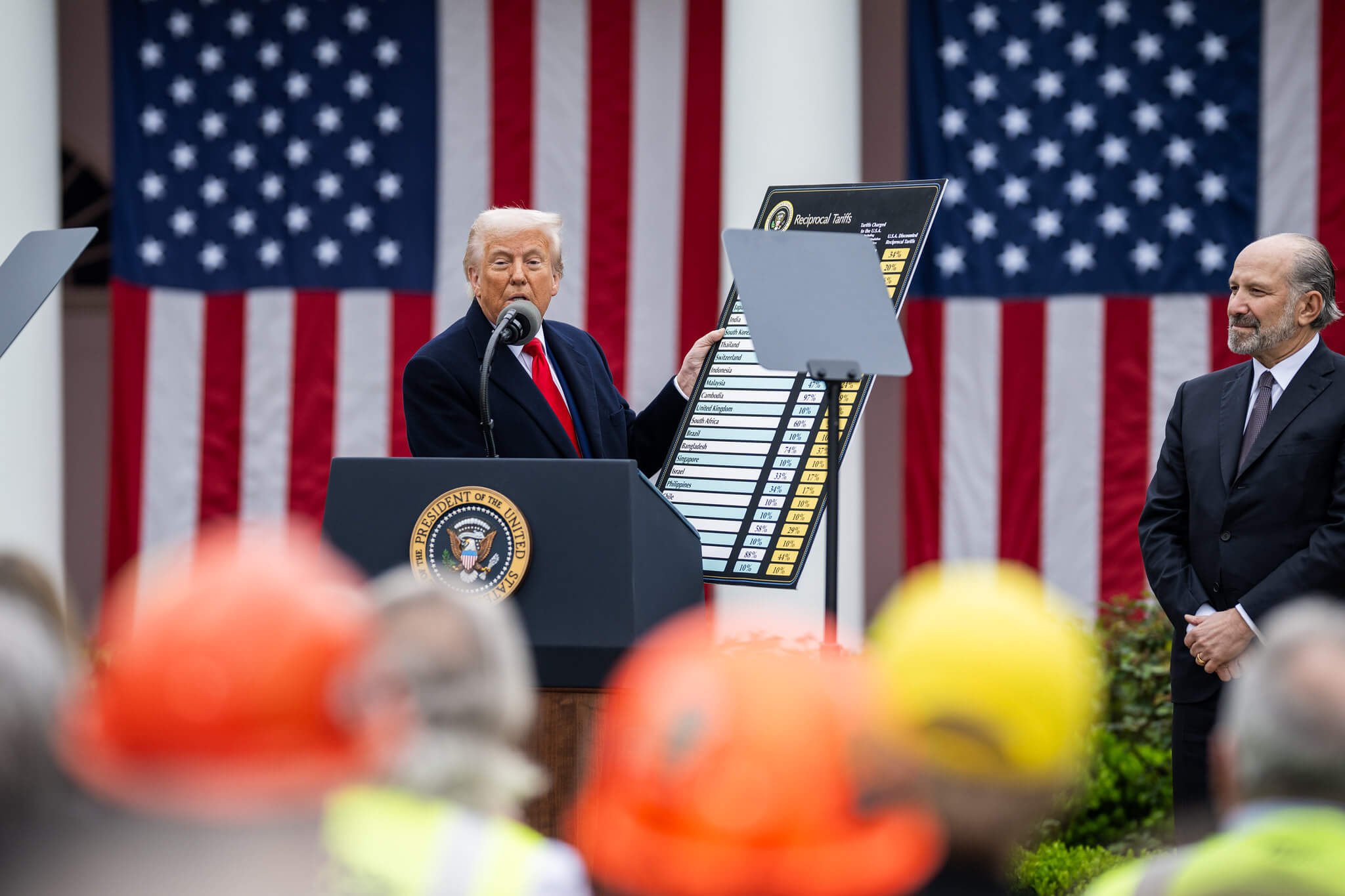Overcoming the Tucker Act After Department of Education v. California
Even after the Supreme Court’s shadow-docket decision, there remain ways to assert award-termination challenges in district court.

Published by The Lawfare Institute
in Cooperation With

In its first two months, the Trump administration has carried out an unprecedented campaign of terminating contracts, grants, and cooperative agreements en masse. More than a dozen lawsuits asserting claims under the Administrative Procedure Act (APA) have followed in short order.
A principal defense of the administration in these suits is that the plaintiffs cannot assert their claims in district court because the Tucker Act creates exclusive jurisdiction for these sorts of claims in the Court of Federal Claims (CFC). This defense can be a significant obstacle to obtaining prompt judicial review and relief—even with respect to terminations that, in many cases, are clearly unlawful. Among other limitations, the CFC generally can award only money damages at the end of a case rather than preliminary injunctive relief. Funding recipients also cannot raise before the CFC the constitutional and statutory claims that are often (but not always) the most compelling claims in these cases.
Unfortunately, the Supreme Court recently dealt a setback to litigants’ efforts to assert APA claims in district court in its shadow-docket decision in Department of Education v. California. The Court’s brief order granting a stay by a vote of 5-4 concluded that the government was likely to show that the APA claims in that case, which sought to reinstate various terminated awards, were instead required to be asserted in the CFC. The government is already relying on the Supreme Court’s decision in arguing for the dismissal of other pending cases seeking the restoration of awards.
Notwithstanding California, there remain ways that litigants can surmount the administration’s Tucker Act defense. In particular, litigants might try two strategies. First, they might assert nonstatutory causes of action based on constitutional or statutory violations. Such claims do not rely on the APA’s waiver of sovereign immunity at all, and the CFC would typically lack jurisdiction to hear the claims because the relevant constitutional and statutory provisions are not “money-mandating.” Second, where the government’s award terminations result in entirely or almost entirely shutting down a congressionally mandated program, litigants might challenge the shutting down of the program—rather than the individual award terminations—as the relevant agency action for APA purposes. The remedy for such a challenge would be to compel the government to issue new awards to operate the program, even if the grantees whose awards were terminated are not guaranteed to receive the new awards.
Background on Relevant Statutory Schemes
The United States generally enjoys sovereign immunity from suit unless Congress waives that immunity by statute. The APA and the Tucker Act each waive sovereign immunity for certain types of claims seeking certain types of relief.
The APA provides a generally applicable waiver for challengers to federal agency action, waiving sovereign immunity for APA claims brought by persons aggrieved by agency action if the claims “seek[] relief other than money damages.” But the same section of the APA also specifies that there is no sovereign immunity waiver for an APA claim “if any other statute ... expressly or impliedly forbids the relief which is sought” in the APA case.
The Tucker Act provides a waiver of sovereign immunity for those asserting contract claims against the federal government and seeking money damages. Specifically, the act confers jurisdiction upon the CFC “to render judgment upon any claim against the United States founded ... upon any express or implied contract with the United States,” or upon certain constitutional or statutory provisions that mandate the payment of money, as described below. The Tucker Act is merely a jurisdictional statute, and therefore plaintiffs filing suit in the CFC must identify “a substantive source of law that creates the right to recovery of money damages against the United States.” Contractors typically can bring common law breach of contract actions in the CFC because money damages are presumed for government breaches.
To bring a constitutional or statutory claim in the CFC, however, plaintiffs must establish that the particular provision is “money-mandating.” A provision is money-mandating only if it “can fairly be interpreted as mandating compensation by the Federal Government for the damage sustained.” For example, the Takings Clause is a constitutional provision that the U.S. Court of Appeals for the Federal Circuit found to be money-mandating.
In contrast, the Federal Circuit has held that the CFC lacks jurisdiction over claims under the Due Process Clause, the Equal Protection Clause, and the First Amendment—as well as the doctrine of separation of powers—because they do not mandate the payment of money to specific persons as damages for violations. Examples of money-mandating statutes include the Back Pay Act, which requires payments to individuals when certain conditions are met, and 37 U.S.C. § 242 (which has since been repealed), which mandated compensation to specified prisoners of war. However, the Federal Circuit has held that statutes providing for formula grants are not money-mandating, even if they require specific awards to specific entities, if the grants are awarded pursuant to “string-attached” agreements rather than a “free and clear transfer of money.”
The CFC generally can award only monetary damages in contract actions. The CFC does have limited authority to grant equitable relief where it is “an incident of and collateral to” a money judgment, but that standard is rarely met.
Department of Education v. California
Over the past several months, plaintiffs and the Trump administration have battled over whether the CFC’s jurisdiction deprives a district court of jurisdiction to hear APA claims relating to award terminations. The Supreme Court’s decision in California may give a preview of how the Court understands the interaction between these statutory schemes, although the meaning—and limitations—of that decision remain in question.
In California, eight states filed suit to challenge the blanket termination of grants previously awarded under two Department of Education grant programs. The district court granted a temporary restraining order on the grounds that the department’s “standardized form letter” failed to provide a “reasoned explanation” for its decision to terminate the grants, rendering the decision arbitrary and capricious under the APA. The court therefore directed the department to “immediately restore Plaintiff States to the pre-existing status quo prior to the termination"and “temporarily enjoined" the department from terminating the relevant grants, except as otherwise consistent with law. After the First Circuit declined to stay the court’s order pending appeal, the department sought relief from the Supreme Court.
The Supreme Court granted a stay pending appeal, with Chief Justice John Roberts (without explanation) and Justices Sonia Sotomayor, Elena Kagan, and Ketanji Brown Jackson voting to deny the application. The majority’s three-page opinion devoted less than a single paragraph to explaining why it believed “the Government is likely to succeed in showing the District Court lacked jurisdiction to order the payment of money under the APA.” The Court acknowledged, quoting Bowen v. Massachusetts, that “a district court’s jurisdiction ‘is not barred by the possibility’ that an order setting aside an agency’s action may result in the disbursement of funds.” But the Court instead relied on another case, Great-West Life & Annuity Insurance Co. v. Knudson, that it characterized as holding that “the APA’s limited waiver of immunity does not extend to orders ‘to enforce a contractual obligation to pay money’ along the lines of what the District Court ordered here.” Cases seeking such relief under the APA, the Court concluded, must instead be brought in the Court of Federal Claims under the Tucker Act.
The Court’s decision is difficult to reconcile with Bowen and its progeny, as the three dissenting justices noted. The challenge in Bowen was to the federal government’s “refusing to reimburse a State for a category of expenditures under its Medicaid program.” The entire purpose of the case thus was an effort to compel a payment of money; it was not an incidental feature of the case, as the California majority suggests. What’s more, Bowen refuted the very premise of Californiareasoning—that the Tucker Act provides the CFC with “exclusive” jurisdiction. Bowen held that, “although [i]t is often assumed that the Claims Court has exclusive jurisdiction of Tucker Act claims, ... [t]hat assumption is not based on any language in the Tucker Act granting such exclusive jurisdiction to the Claims Court. Rather, that court’s jurisdiction is ‘exclusive’ only to the extent that Congress has not granted any other court authority to hear the claims that may be decided by the Claims Court,” such as APA claims seeking equitable relief.
Moreover, as Justice Kagan noted, the Court’s reliance on Great-West was puzzling, given that Great-West “was not brought under the APA”—which is how Great-West distinguished Bowen. The Court’s decision is even harder to square with its own decision a month earlier in Department of State v. AIDS Vaccine Advocacy Coalition, which denied the government’s application to stay an order barring it from “enforcing directives pausing disbursements of foreign development assistance funds” based on the APA. Notably, Justice Amy Coney Barrett switched her decisive fifth vote and did not write separately in either case.
It is important to emphasize that California is a quintessential shadow-docket decision—a preliminary determination, rendered exceedingly quickly, and without the benefit of either a final decision from the lower courts or merits briefing from the parties. The Supreme Court can stay a district court’s order on the shadow docket, and has done so, only to affirm it later on.
Moreover, the Court’s interim decision may not necessarily preclude APA challenges to other award-related actions. The Court’s reasoning turned on the premise that, by directing the government to reinstate grants, the district court’s order sought to enforce a contractual obligation. But it is questionable that constitute . A contract requires consideration—which courts have interpreted in this context to require that the agreement “render a benefit to the government,” which must be “tangible and direct, rather than generalized or incidental.” Programs that serve generalized public benefits may not qualify, along with formula grants disbursed under statutes that are not money-mandating. Although California involved grants, the states did not raise the argument that the grants there should not be considered contracts, and therefore the issue was not presented to the Court. And not all remedies seek to a contractual obligation. Relief that seeks to enjoin or set aside a broad directive, and does not ask the court to reinstate (or force the agency to pay out) any particular award or awards, may come closer to the form of relief typically sought in an APA action, and which the Court seemingly allowed to proceed in AIDS Vaccine Advocacy Coalition.
Litigants and the lower courts are currently grappling with the import of the Court’s order in California. In American Association of Colleges for Teacher Education v. McMahon, over the objection of plaintiffs who argued (among other things) that the result in California was driven more by the equities than by the Court’s brief Tucker Act analysis, a unanimous panel of the Fourth Circuit stayed the district court’s preliminary injunction in a one-sentence order citing California. Yet four district courts have already issued decisions reading California narrowly, suggesting that certain APA challenges to award-related actions may still be pursued in district court. Litigants might continue to press on these issues as their cases progress.
The Availability of Nonstatutory Review
Nevertheless, litigants should consider California carefully in deciding how to frame challenges associated with award-related action. Although there may be some wiggle room in the Supreme Court’s interim reasoning, the decision suggests that the Court may take a dim view of APA challenges. Litigants seeking preliminary relief—including relief that will survive appellate review—might therefore consider approaches that avoid the shadow that California casts.
To start, litigants asserting constitutional or statutory claims might consider avoiding the APA entirely, and instead asserting a nonstatutory cause of action. Indeed, in a March 8 oral argument in a case involving the suspension of foreign aid funding, counsel for the government conceded that its Tucker Act defense does not apply to a nonstatutory cause of action seeking to enjoin an official’s actions for violating the constitutional separation of powers.
The government made this concession for good reason. The government’s Tucker Act defense rests on the APA’s proviso that it does not waive sovereign immunity where another statute “impliedly forbids” the APA relief sought. However, a nonstatutory cause of action, such as a claim that government action is ultra vires, need not rely on the APA’s waiver of sovereign immunity but can instead rely on the Larson-Dugan exception to sovereign immunity. Specifically, where an “‘officer is not doing the business which the sovereign has empowered him to do,’” “there is no sovereign immunity to waive—it never attached in the first place.” Thus, litigants bringing claims against the freezing or termination of their awards might consider asserting at least one nonstatutory separation-of-powers cause of action.
Moreover, even if the government develops a new argument for why the Tucker Act precludes litigants from asserting nonstatutory claims in district court, those arguments should fail, especially for constitutional claims. Recall that the CFC lacks jurisdiction over constitutional or statutory claims unless the constitutional or statutory provisions are money-mandating.The constitutional or statutory provisions that would form the predicate for challenging the termination of grants and contracts—for example, constitutional separationofpowers, the relevant appropriations or authorizing statutes, and the Impoundment Control Act—are typically not money-mandating as that phrase has been narrowly interpreted. If a district court dismissed nonstatutory claims grounded on these provisions and the plaintiff then refiled them in the CFC, the CFC would likely dismiss the claims for lack of jurisdiction as well. The plaintiff would be left with no judicial forum to pursue their constitutional or statutory claims relating to their contract or grant, an outcome that the D.C. Circuit has “categorically reject[ed].”
Consider, for example, if the federal government froze or terminated a grant explicitly based on the race or gender of the grantee. Under the government’s theory, the grantee would have no forum to mount a constitutional challenge to such action. That cannot be right.
Fortunately, Supreme Court precedent forecloses this outcome. The Supreme Court held in Webster v. Doe that “where Congress intends to preclude judicial review of constitutional claims, its intent to do so must be clear.” That “heightened showing” is required “in part to avoid the ‘serious constitutional question’ that would arise if a federal statute were construed to deny any judicial forum for a colorable constitutional claim.” The Tucker Act lacks the requisite clear intent to foreclose judicial review of colorable constitutional claims. After all, the Tucker Act does not expressly preclude judicial review at all. The solicitor general’s argument in California was that the CFC’s jurisdiction “impliedly” precludes APA challenges to award terminations. Impliedly is the opposite of expressly.
Challenges to Program Shutdowns
An alternative approach for challenging the government’s mass terminations of awards is to challenge the government’s decision to shut down an entire statutory programand to seek an order compelling the government to comply with its statutory duties to operate the program. With many of the administration’s mass firings, it has terminated all or nearly all contracts or grants issued under a program mandated by statute, without any plans to issue new awards. Where an authorizing statute provides that an agency “shall” issue contracts or grants to carry out a particular program, the agency’s decision to shut down the program would clearly violate the statute. In addition, where Congress has appropriated funds to an agency specifically to carry out a program, the decision to not expend those funds likely violates the statute and the separation of powers.
Grantees and contractors likely have standing to bring these claims, as courts have long recognized that losing the opportunity to compete for a government program can constitute Article III injury. Beneficiaries of the programs other than the grantees and contractors might have standing to bring these claims as well.
The obvious downside to this claim, from the perspective of a terminated grantee or contractor, is that the relief may not inure to their direct benefit. Whether to bring such a claim thus likely will depend on a number of strategic considerations.
***
Our analysis (like the Court’s decision in California) is necessarily preliminary. Courts will continue to weigh in on these issues in the coming weeks, and litigants would be welladvised to stay abreast of these developments. At present, however, there may still be multiple ways to continue asserting challenges to award terminations in district court, rather than the CFC.






